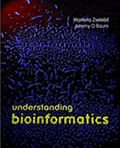
ISBN: 0815340249
Author(s): Market Zvelebil
Paperback; 304 pages; Garland Science; 1 edition (April 30, 2007)
The book is divided into seven sections, with the opening section introducing the basics of nucleic acids, proteins and databases. Subsequent sections are divided into 'applications' and 'theory' chapters, allowing readers to focus their attention effectively. In each section, the applications chapter provides a fast and straightforward route to understanding the main concepts and 'getting started'. Each of these is then followed by theory chapters which give greater detail and present the underlying mathematics. In section two, Sequence Alignments, the applications chapter shows the reader how to get started on producing and analyzing sequence alignments, and using sequences for database searching, while the next two chapters look closely at the more advanced techniques and the mathematical algorithms involved. Section three covers evolutionary processes and shows how bioinformatics can be used to help build phylogenetic trees. Section four looks at the characteristics of whole genomes. In Sections five and six the focus turns to secondary and tertiary structure – predicting structural conformation and analysing structure-function relationships. The last section surveys methods of analyzing data from a set of genes or proteins of an organism and is rounded off with an overview of systems biology.
The writing style of Understanding Bioinformatics is notable for its clarity, while the extensive, full-color artwork has been designed to present the key concepts with simplicity and consistency. Each chapter uses mind-maps and flow diagrams to give an overview of the conceptual links within each topic.